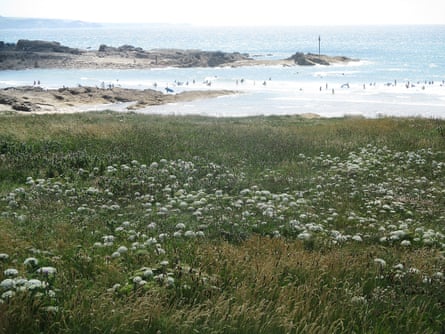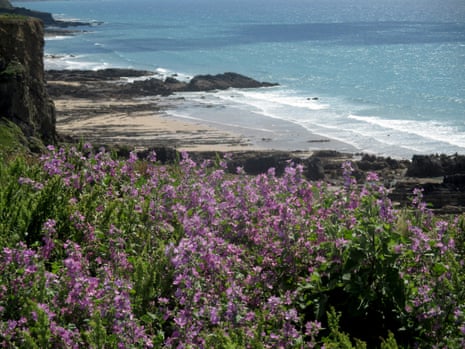The satellite listening dishes of GCHQ at Morwenstow poke up above the northern horizon, and offshore the ocean is cornflower blue. Beside the bunkers and fairways of the golf course, ringlets flit about thyme, lady’s bedstraw and fluffy grasses, and, towards Burn Park holiday complex and St Olaf’s church at Poughill, the gravelled way is shaded by hedgerow elms. Within the church, a plaque commemorates the death in 1875 of Sir Goldsworthy Gurney, inventor and polymath of Bude Castle. A pair of frescoes, “washed out” (ie whitewashed over) in 1550, were rediscovered and vividly repainted in 1894, and show Saint Christopher striding across a ford with fish and a mermaid regarding her reflection in a mirror.
Rough tracks progress north to cross sluggish streams cut deep into the bedrock; meadowsweet and horsetail grow in damp mud, and dried-up ramsons and seeding primroses proliferate beneath the canopy of wind-shaped oaks and yet more elms with suckering growth.
Away from the shade, at Mount Pleasant, views extend down-coast, past Bude to Dizzard Wood, Tintagel, The Rumps and the hinterland of pale green pastures and tawny hayfields beneath Bodmin Moor. Hot midday sun strikes an expanse of photovoltaic panels on the roof of a car-body repair specialist and, coastwards of Tiscott, hard-baked clayey fields planted with maize are edged in regularly shorn banks draped in honeysuckle and flowering blackberry.
Closer to Northcott Mouth, the swish of gentle waves and song of skylark become apparent and, by the rustic tea garden, swallows and sand martins glide above the shallow stream. Southwards, across Maer Down, swaths of hay readied for baling adjoin mallow, shrivelled thrift and the domed umbels of wild carrot, growing along the edge of the earthy cliffs that overlook outgoing tide and eroded spines of contorted rock folds.

Back in Bude, people spread out across lifeguarded Crooklets and Summerleaze beaches and head seawards to swim and surf; others stroll beside the old canal. “Sand rails” remind of days when sand was valued as a fertiliser, gathered from the beach, dragged along the tramway and loaded into wheeled tub boats that could be floated as well as hauled up intervening inclines along the canal, wending more than 30 miles inland.

Comments (…)
Sign in or create your Guardian account to join the discussion